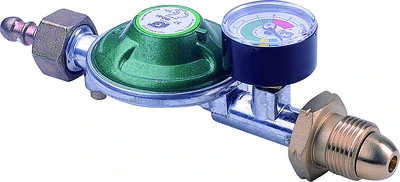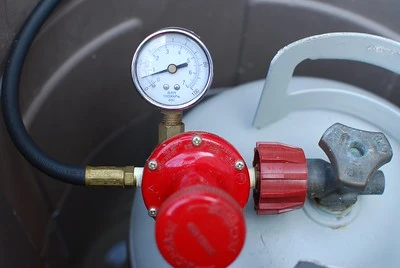
1. Turn Off the Gas Supply
- Why: Before doing anything, you must ensure safety by turning off the gas. This prevents any leaks while you’re working on the regulator.
- How: Locate the valve on the gas tank and turn it clockwise until it’s fully closed.
2. Disconnect the Regulator
- Why: To properly clean the regulator, it needs to be removed from the tank.
- How: Unscrew the regulator from the LPG tank by turning the connection nut counterclockwise.
3. Inspect for Visible Dirt or Debris
- Why: Sometimes, dust or small particles clog the regulator and block the flow of gas.
- How: Check the outside and inside of the regulator for any visible dirt or blockages.
4. Use Compressed Air
- Why: Blowing compressed air through the regulator helps dislodge any particles that may be stuck inside.
- How: Hold the regulator and blow compressed air through the inlet and outlet ports. Make sure to use short bursts to avoid damage.
5. Clean with Soapy Water
- Why: If the regulator appears greasy or has buildup, a soapy solution can help clean it.
- How: Mix mild dish soap with warm water, dip a soft brush or cloth in it, and gently scrub the regulator. Be careful not to submerge the entire regulator, just clean the outer parts.
6. Rinse and Dry
- Why: You don’t want soap residue or water left in the regulator, as this can lead to corrosion or blockages.
- How: After cleaning with soapy water, use a damp cloth to wipe the regulator, and then dry it thoroughly with a dry towel or let it air dry.
7. Inspect the Diaphragm
- Why: The diaphragm inside the regulator controls gas flow and might also be clogged or damaged.
- How: If you have experience, you can carefully open the regulator and check the diaphragm. If it’s damaged or has debris, it may need to be cleaned or replaced.
8. Reconnect and Test
- Why: After cleaning, it’s important to ensure everything is working properly.
- How: Reconnect the regulator to the LPG tank, turn on the gas, and check for any leaks by applying soapy water around the connections. If no bubbles appear, it’s safe to use.
You can clean your LPG regulator and keep it functioning efficiently. If the clog persists or you’re unsure about cleaning it yourself, it’s best to contact a professional for help.
Dip the Regulator into a Soap and Water Solution
Submerge the regulator in a mix of soap and water. Be sure not to soak it completely, just dip the part that needs cleaning. Use a soft brush or cloth to scrub away any dirt or grime, then rinse it off with clean water. Make sure to dry it thoroughly before using it again.
After drying the regulator, inspect it for any remaining dirt or blockages. If everything looks clean, reconnect it to the propane tank. Turn the gas back on and check for leaks by applying soapy water around the connections. If no bubbles form, the regulator is good to go and safe to use. If you still notice issues with the gas flow, it might be time to replace the regulator or seek professional help.
If after reconnecting the regulator you still experience weak gas flow or irregular performance, it may mean the regulator is beyond cleaning and needs to be replaced. It’s always a good idea to keep an eye on your regulator over time for any signs of wear or corrosion.
Regular checks can help prevent future clogs and keep your propane system running safely and efficiently. If you’re unsure or uncomfortable handling it, don’t hesitate to contact a professional to inspect or replace the regulator.
Reasons Why Propane Gas Regulator Gets Clogged

Here are some reasons why a propane gas regulator can get clogged, explained in simple terms:
1. Dust and Dirt Buildup
- Over time, dust, dirt, and debris can find their way into the regulator, especially if the tank or hose connections are exposed. These particles can block the flow of gas.
- How it Happens: When the regulator is left in open areas or not properly covered, dust can accumulate in the small openings.
2. Rust or Corrosion
- Metal parts inside the regulator can rust or corrode, especially if they are exposed to moisture. This rust can flake off and clog the gas flow.
- How it Happens: Propane tanks and regulators are often stored outside, making them vulnerable to weather conditions, including rain and humidity.
3. Oil or Grease Contamination
- Sometimes, oil or grease can accidentally get into the propane system, leading to clogging. These substances don’t mix well with gas flow and can cause blockages.
- How it Happens: Contaminated hoses, connections, or even impurities in the propane itself can introduce oil or grease into the regulator.
4. Spider Webs or Insects
- Believe it or not, spiders and insects can crawl into the small openings of the regulator and build webs or nests, which can cause a blockage.
- How it Happens: If the regulator is left uncovered, insects can enter through the openings and create obstructions that interfere with the gas flow.
5. Frozen Moisture Inside the Regulator
- If moisture gets inside the regulator, it can freeze, especially in cold weather, blocking the flow of propane.
- How it Happens: This usually happens in areas with high humidity or if the propane tank is exposed to condensation. The moisture freezes and creates a blockage.
6. Propane Residue
- Over time, the propane gas itself can leave behind a residue or sticky substance, which can build up inside the regulator and block the flow.
- How it Happens: This occurs when propane tanks are not well-maintained or if they contain impurities that accumulate in the regulator.
7. Wear and Tear
- As regulators age, their internal parts wear down, which can lead to blockages or poor performance.
- How it Happens: Regular use over the years causes small parts inside the regulator to degrade, leading to malfunction or clogging.
These are the common reasons a propane regulator may become clogged, and regular maintenance or inspection can help prevent these issues.
Buying a New One vs. Cleaning an Old One
When it comes to maintaining your propane system, you might wonder if it’s better to clean your old regulator or simply buy a new one. Here’s a breakdown to help you decide:
| Criteria | Cleaning an Old Regulator | Buying a New Regulator |
|---|---|---|
| Cost-Effectiveness | Cleaning is cheaper, requiring only basic supplies like soap and water. | Buying new is more expensive upfront but eliminates the hassle of maintenance. |
| Condition of the Regulator | If in good shape, cleaning can extend its life. | If the regulator is corroded or damaged, replacing it is safer. |
| Time and Effort | Cleaning requires disassembly, effort, and testing. | Buying new is quick and simple, requiring only installation. |
| Safety Considerations | If done properly, cleaning is safe but requires care. | A new regulator guarantees proper function and safety. |
| Frequency of Use | Cleaning works for occasional maintenance. | A new regulator offers better reliability for frequent use. |
In the end, cleaning works well for minor issues, but if your regulator is old or damaged, investing in a new one may be the best choice for safety and reliability.
To Make a Conclusion
Cleaning an LPG regulator is a straightforward process that can help keep your propane system running smoothly. Start by turning off the gas supply and safely disconnecting the regulator. Check for dirt or debris and use compressed air to blow out any blockages.
For greasy buildup, dip the regulator in a soapy water solution and gently scrub it clean. Always make sure to dry it thoroughly before reconnecting. If you notice the regulator is still not working properly after cleaning, it may be time to replace it or seek professional help. Regular maintenance ensures your regulator stays in good shape, providing safe and efficient gas flow.
Image source: Integrated Gas Technologies (Flickr)

Jeremy is a highly experienced professional propane technician with over 21 years of experience in the industry. Throughout his career, he has gained extensive knowledge and expertise in propane gas installation, maintenance, and repair, as well as in ensuring safety and compliance with industry standards. Mike has worked with various residential, commercial, and industrial clients, providing top-notch services and solutions to meet their propane needs. He is dedicated to his craft and passionate about delivering exceptional service to his clients.



